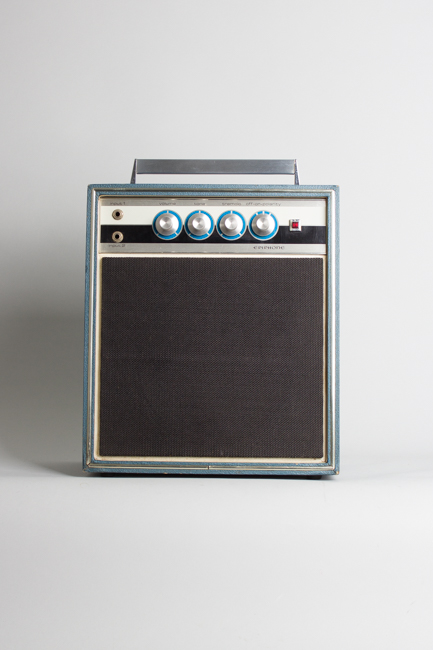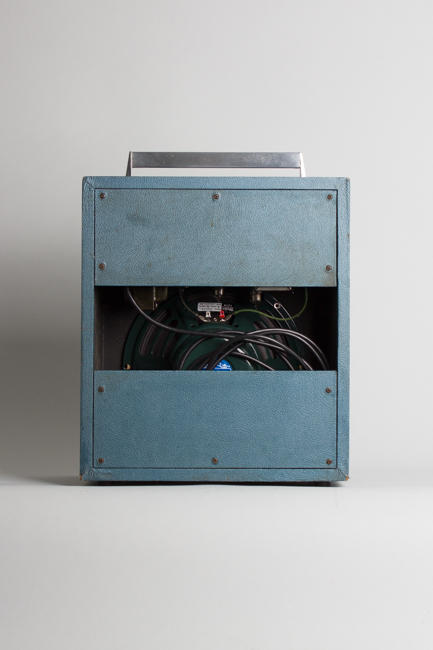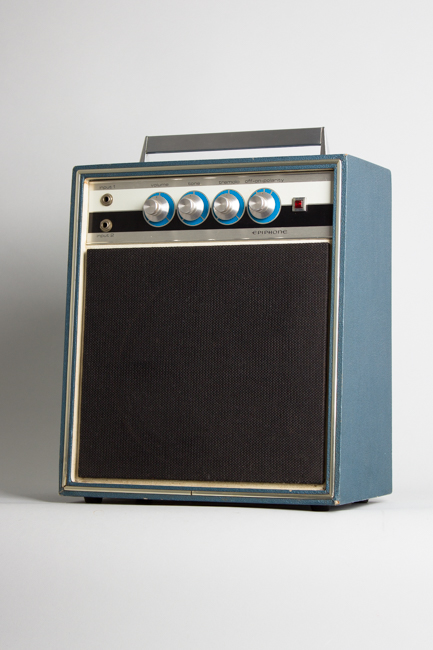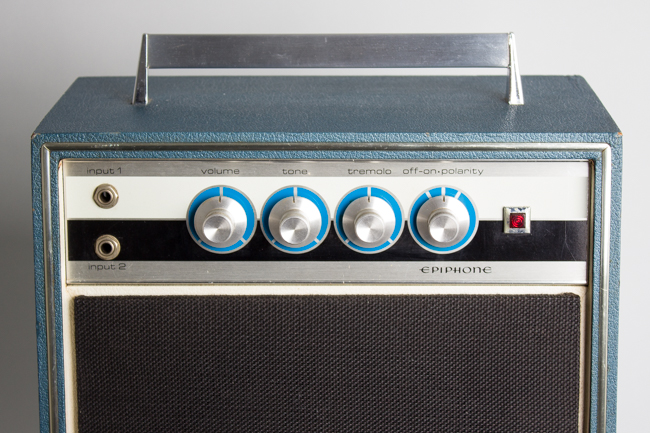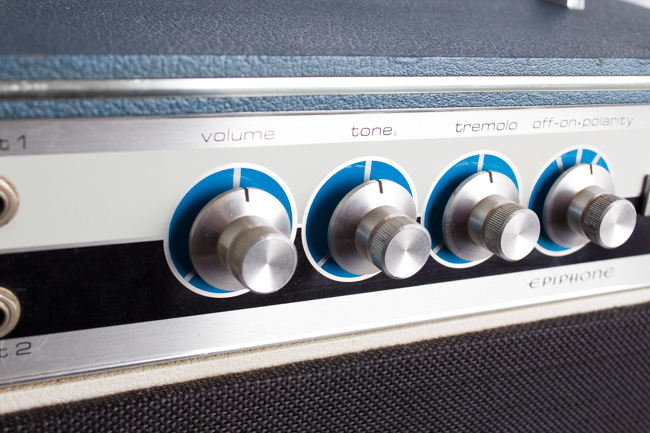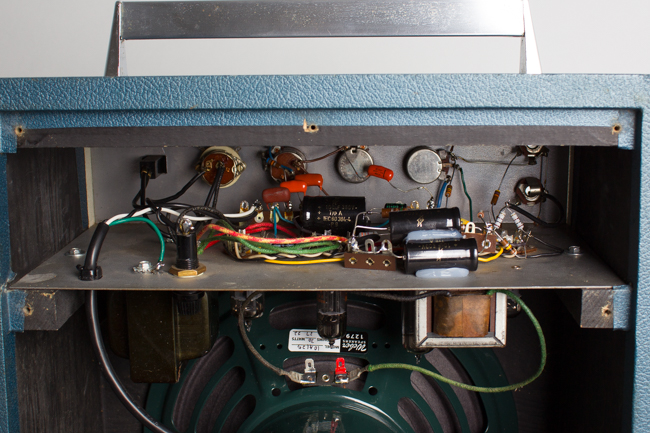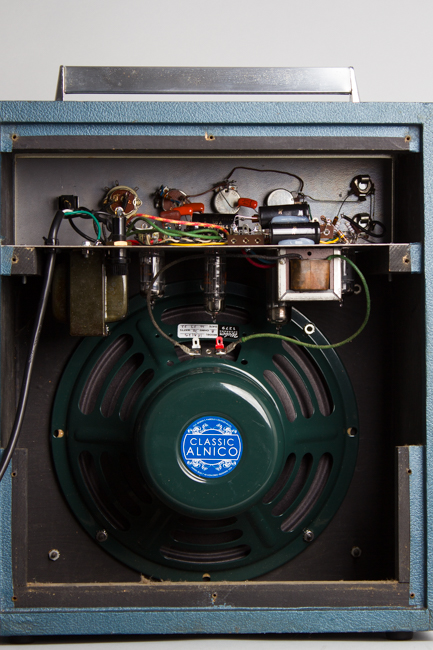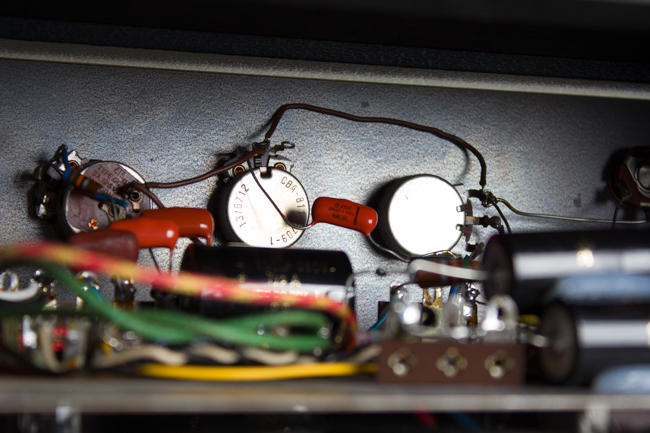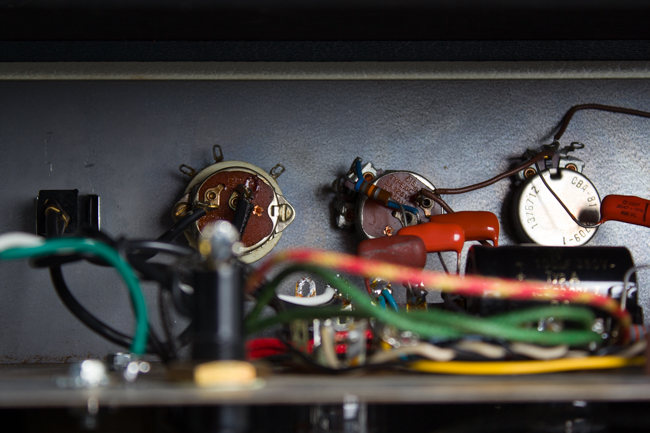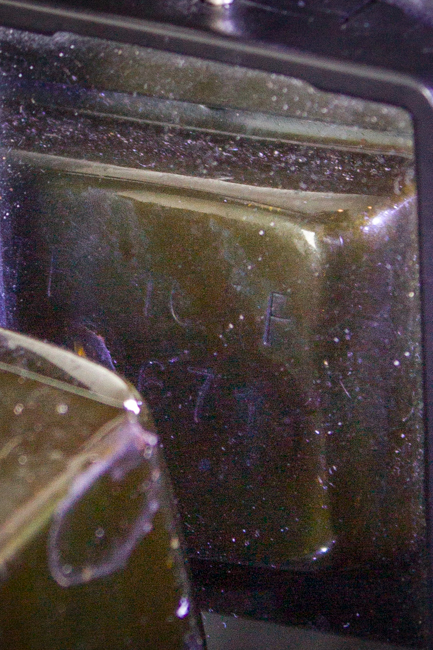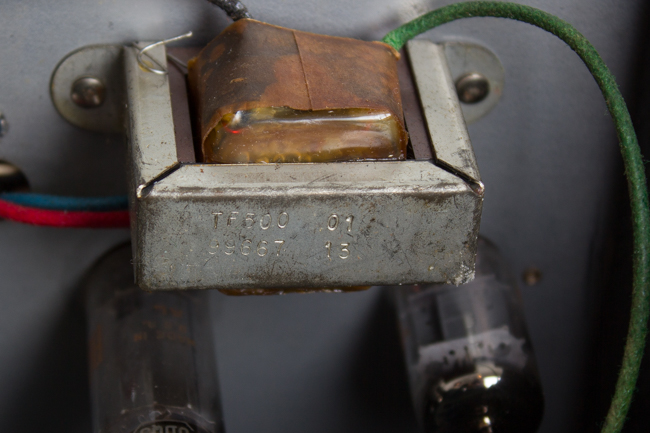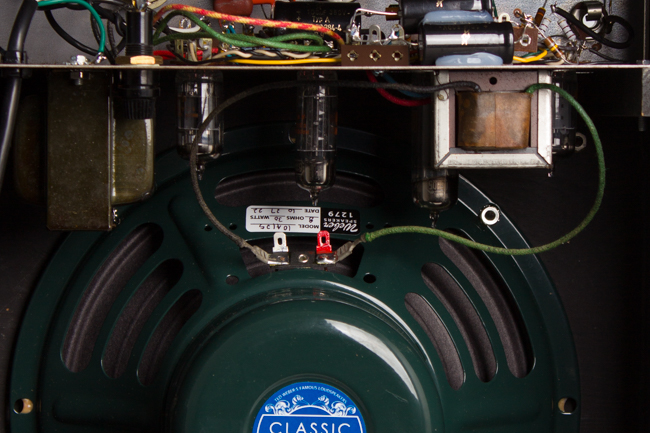Epiphone EA-101 Tube Amplifier (1967)
Just Arrived!
This item is currently on hold.
Item # 12123
Prices subject to change without notice.
Epiphone EA-101 Model Tube Amplifier (1967), made in Kalamazoo, Michigan, serial # 2020, blue/grey Tolex finish.
In the 1960s Epiphone was just one of CMI's (Chicago Musical Instruments, Gibson's parent company) brands, often appearing as a slightly more affordable alternative to Gibson's line-up of instruments and amplifiers. This small futuristic looking amplifier was an especially budget friendly late addition to the Epiphone amp line. They appear on the 1967 and '68 price lists but not in any earlier catalogs and were only built in small numbers before CMI canned the Epiphone amp line entirely.
Almost exactly mirroring the Kalamazoo Model One and Model Two, these little practice/student amps appear with two model designations, EA-100 and EA-101, the latter having the addition of an onboard tremolo effect. This model thus features a dedicated speed knob (the depth was fixed) in addition to the volume and tone controls. These two circuits were also at one point featured in the Gibson-branded Skylark GA-5 and GA-5T, respectively (not to be confused with the earlier Les Paul-amp adjacent GA-5, which is basically Gibson's take on a Fender Champ).
This little Epiphone amp may have been at the bottom of the line-up in 1967 but represented a surprisingly nice value in a small, well-engineered, point-to-point tube amp. Being $20 more expensive in 1967 than the comparable Kalamazoo Model Two, at $79.50 the EA-101 came with much classier cosmetics as well as a solid wood baffle and cabinet construction. The EA-101 also featured a dedicated knob as the power/polarity switch, unlike the power switch being on the tone control on the Kalamazoos. The sleek and snazzy chrome-and-colored-Tolex styling of these amps has a definite "retro-futurist" character; they look like something Judy Jetson might have played through!
The electronics and stock speakers of both models are practically identical; both lines of amps featuring a great set of transformers made by either Schumacher or Heyboer as well as a tube compliment consisting of RCA and Raytheon branded tubes. A single 6BQ5 (aka EL84) provides around 6 watts of output power into a single 10" speaker. That being said, the circuit design greatly benefits to having some tweaks done, and while we usually work to preserve vintage pieces as designed, we've developed a "Retrofret special" upgrade package for this particular amp, that has greatly grown in popularity with our customers.
Height is 15 1/4 in. (38.7 cm.), 14 in. (35.6 cm.) width, and 8 1/2 in. (21.6 cm.) in depth at deepest point.
Externally, this amp remains in very good shape, especially considering the cabinet's fairly thin Tolex covering. Apart from some minor scuffing along the edges and corners, most notably a couple dings on the lower sides of the cabinet, the cabinet is generally well-intact. Both the baffle and grille cloth are structurally sound and in excellent shape with no visible tearing. The faceplate is remarkably clean and all four of the rare (and often missing) oversized metal knobs are present as well.
Electrically, this example has had a number of circuitry upgrades to improve clarity, response, and tonal muscle as well as to reduce noise and hum, which as built these are quite prone to. It has also had a speaker upgrade to a 10" Weber 10A125, as the original speakers were very low budget. The tremolo has also been tweaked for optimal range of speed and lush depth. The Heyboer-made output transformer bears the code 996-6713, dating it to the 13th week of 1967. The power transformer is original and dates to 1967 as well. The amp has also seen our typical maintenance, including a grounded 3-prong power cord, all electrolytic capacitors replaced, cleaning of all sockets, pots and jacks and power section biased to spec.
This is now a great-sounding little unit, quite a bit louder than as originally designed, with a sturdier low-end and a smoother overdrive curve. This model not only looks cool as heck, but represents an excellent bargain in a small authentic vintage tube combo. We recommend getting two and running them side by side for the ultimate 10-12 watt, double-tremolo stereo rig! Overall Excellent Condition.
In the 1960s Epiphone was just one of CMI's (Chicago Musical Instruments, Gibson's parent company) brands, often appearing as a slightly more affordable alternative to Gibson's line-up of instruments and amplifiers. This small futuristic looking amplifier was an especially budget friendly late addition to the Epiphone amp line. They appear on the 1967 and '68 price lists but not in any earlier catalogs and were only built in small numbers before CMI canned the Epiphone amp line entirely.
Almost exactly mirroring the Kalamazoo Model One and Model Two, these little practice/student amps appear with two model designations, EA-100 and EA-101, the latter having the addition of an onboard tremolo effect. This model thus features a dedicated speed knob (the depth was fixed) in addition to the volume and tone controls. These two circuits were also at one point featured in the Gibson-branded Skylark GA-5 and GA-5T, respectively (not to be confused with the earlier Les Paul-amp adjacent GA-5, which is basically Gibson's take on a Fender Champ).
This little Epiphone amp may have been at the bottom of the line-up in 1967 but represented a surprisingly nice value in a small, well-engineered, point-to-point tube amp. Being $20 more expensive in 1967 than the comparable Kalamazoo Model Two, at $79.50 the EA-101 came with much classier cosmetics as well as a solid wood baffle and cabinet construction. The EA-101 also featured a dedicated knob as the power/polarity switch, unlike the power switch being on the tone control on the Kalamazoos. The sleek and snazzy chrome-and-colored-Tolex styling of these amps has a definite "retro-futurist" character; they look like something Judy Jetson might have played through!
The electronics and stock speakers of both models are practically identical; both lines of amps featuring a great set of transformers made by either Schumacher or Heyboer as well as a tube compliment consisting of RCA and Raytheon branded tubes. A single 6BQ5 (aka EL84) provides around 6 watts of output power into a single 10" speaker. That being said, the circuit design greatly benefits to having some tweaks done, and while we usually work to preserve vintage pieces as designed, we've developed a "Retrofret special" upgrade package for this particular amp, that has greatly grown in popularity with our customers.
Height is 15 1/4 in. (38.7 cm.), 14 in. (35.6 cm.) width, and 8 1/2 in. (21.6 cm.) in depth at deepest point.
Externally, this amp remains in very good shape, especially considering the cabinet's fairly thin Tolex covering. Apart from some minor scuffing along the edges and corners, most notably a couple dings on the lower sides of the cabinet, the cabinet is generally well-intact. Both the baffle and grille cloth are structurally sound and in excellent shape with no visible tearing. The faceplate is remarkably clean and all four of the rare (and often missing) oversized metal knobs are present as well.
Electrically, this example has had a number of circuitry upgrades to improve clarity, response, and tonal muscle as well as to reduce noise and hum, which as built these are quite prone to. It has also had a speaker upgrade to a 10" Weber 10A125, as the original speakers were very low budget. The tremolo has also been tweaked for optimal range of speed and lush depth. The Heyboer-made output transformer bears the code 996-6713, dating it to the 13th week of 1967. The power transformer is original and dates to 1967 as well. The amp has also seen our typical maintenance, including a grounded 3-prong power cord, all electrolytic capacitors replaced, cleaning of all sockets, pots and jacks and power section biased to spec.
This is now a great-sounding little unit, quite a bit louder than as originally designed, with a sturdier low-end and a smoother overdrive curve. This model not only looks cool as heck, but represents an excellent bargain in a small authentic vintage tube combo. We recommend getting two and running them side by side for the ultimate 10-12 watt, double-tremolo stereo rig! Overall Excellent Condition.
